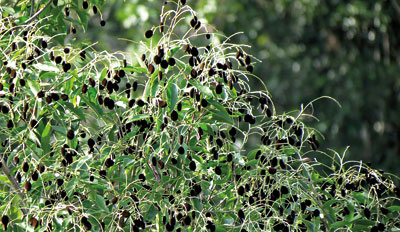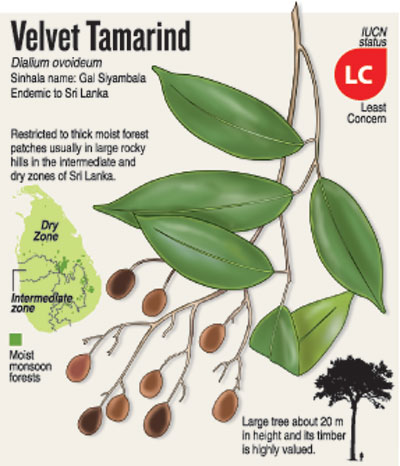News
Brutal harvesting of gal siyambala treat leaves sour taste
With the gal siyambala season at its height experts are warning that unsustainable harvesting methods are pushing the fruit tree towards extinction while prices for the product have soared.

Gal Siyambala tree laden with fruit. Pic by Ashan Geeganage
With its velvet coat and sweetish acidic taste the gal siyambala or velvet tamarind has been a delicacy for generations.
The velvet tamarind tree (Dialium ovoideum) grows in evergreen monsoon forests and near rivers, especially in dry and semi-arid zones. It is not cultivated, so the fruit is harvested directly from the trees in the forests.
Increasingly, the harvesting is greedy and brutal, with little regard for conserving the health of the tree. Organised gangs from nearby villages go into the forest and chop down entire branches of the trees in order to pluck the fruit off them. It is common to find the remnants of these cut branches left under the trees.
Last week, 50g of gal siyambala fetched Rs. 80 at Dehiwala, with vendors lamenting that the fruit’s rarity increased the price.
Decades ago, gal siyambala could be found in large heaps at roadside fruit stalls and markets from August, when its season begins. Blooms appear on the trees from February to April and the fruits come on the market from August to November.
“At the end of August we visited a forest patch in Siyambalanduwa,” said Dr. Ashan Geeganage, who lives in Moneragala and has been lucky enough to taste the fruit directly from the tree.
“We found several gal siyambala trees, but only two of them had fruit. The fruits on the other trees had been plucked and some of the trees were chopped up very badly,” he said.
The head of the Department of Crop Science at the University of Peradeniya, Professor D K N G Pushpakumara, said this kind of harvesting was destructive and affected the fruiting of the following year’s crop.
Velvet tamarind trees are also cut down for the value of their timber as they can grow 30m high.
The species is now classified as “vulnerable” to extinction. The National Red List 2012 of Sri Lanka: Conservation Status of the Fauna and Flora, published by the Department of the Environment, lists 177 plants as “possible extinct” while a third of 3,154 species of Sri Lanka’s flora are listed as “threatened”.\


